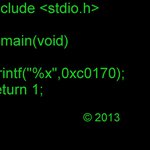The official Mbed 2 C/C++ SDK provides the software platform and libraries to build your applications.
Dependents: hello SerialTestv11 SerialTestv12 Sierpinski ... more
mbed 2
This is the mbed 2 library. If you'd like to learn about Mbed OS please see the mbed-os docs.
Diff: hal/critical_section_api.h
- Revision:
- 165:d1b4690b3f8b
- Child:
- 172:65be27845400
--- /dev/null Thu Jan 01 00:00:00 1970 +0000
+++ b/hal/critical_section_api.h Thu Apr 19 14:31:27 2018 +0100
@@ -0,0 +1,107 @@
+/** \addtogroup hal */
+/** @{*/
+/* mbed Microcontroller Library
+ * Copyright (c) 2006-2017 ARM Limited
+ *
+ * Licensed under the Apache License, Version 2.0 (the "License");
+ * you may not use this file except in compliance with the License.
+ * You may obtain a copy of the License at
+ *
+ * http://www.apache.org/licenses/LICENSE-2.0
+ *
+ * Unless required by applicable law or agreed to in writing, software
+ * distributed under the License is distributed on an "AS IS" BASIS,
+ * WITHOUT WARRANTIES OR CONDITIONS OF ANY KIND, either express or implied.
+ * See the License for the specific language governing permissions and
+ * limitations under the License.
+ */
+#ifndef MBED_CRITICAL_SECTION_API_H
+#define MBED_CRITICAL_SECTION_API_H
+
+#include <stdbool.h>
+
+#ifdef __cplusplus
+extern "C" {
+#endif
+
+/**
+ * \defgroup hal_critical Critical Section HAL functions
+ * @{
+ */
+
+/**
+ * Mark the start of a critical section
+ *
+ * This function will be called by core_util_critical_section_enter() each time
+ * the application requests to enter a critical section. The purpose of the
+ * critical section is to ensure mutual-exclusion synchronisation of the
+ * processor by preventing any change in processor control, the default
+ * behaviour requires storing the state of interrupts in the system before
+ * disabling them.
+ *
+ * The critical section code supports nesting. When a thread has entered a
+ * critical section it can make additional calls to
+ * core_util_critical_section_enter() without deadlocking itself. The critical
+ * section driver API tracks the number of nested calls to the critical section.
+ * The critical section will only be exited when
+ * core_util_critical_section_exit() has been called once for each time it
+ * entered the critical section.
+ *
+ * On the first call to enter a critical section this function MUST store the
+ * state of any interrupts or other application settings it will modify to
+ * facilitate the critical section.
+ *
+ * Each successive call to enter the critical section MUST ignore storing or
+ * modifying any application state.
+ *
+ * The default implementation of this function which will save the current state
+ * of interrupts before disabling them. This implementation can be found in
+ * mbed_critical_section_api.c. This behaviour is can be overridden on a per
+ * platform basis by providing a different implementation within the correct
+ * targets directory.
+ */
+void hal_critical_section_enter(void);
+
+
+/** Mark the end of a critical section.
+ *
+ * The purpose of this function is to restore any state that was modified upon
+ * entering the critical section, allowing other threads or interrupts to change
+ * the processor control.
+ *
+ * This function will be called once by core_util_critical_section_exit() per
+ * critical section on last call to exit. When called, the application MUST
+ * restore the saved interrupt/application state that was saved when entering
+ * the critical section.
+ *
+ * There is a default implementation of this function, it will restore the state
+ * of interrupts that were previously saved when hal_critical_section_enter was
+ * first called, this implementation can be found in
+ * mbed_critical_section_api.c. This behaviour is overridable by providing a
+ * different function implementation within the correct targets directory.
+ */
+void hal_critical_section_exit(void);
+
+
+/** Determine if the application is currently running in a critical section
+ *
+ * The purpose of this function is to inform the caller whether or not the
+ * application is running in a critical section. This is done by checking if
+ * the current interrupt state has been saved in the underlying implementation,
+ * this could also be done by checking the state of the interrupts at the time
+ * of calling.
+ *
+ * @return True if running in a critical section, false if not.
+ */
+bool hal_in_critical_section(void);
+
+
+/**@}*/
+
+#ifdef __cplusplus
+}
+#endif
+
+#endif // MBED_CRITICAL_SECTION_API_H
+
+/** @}*/
 mbed official
mbed official




